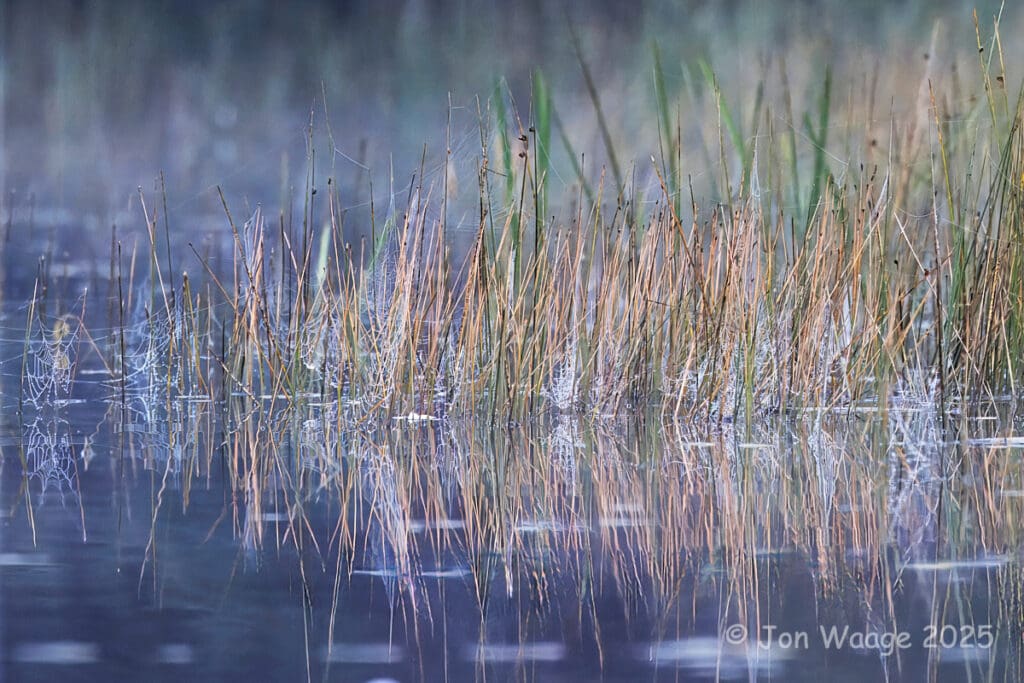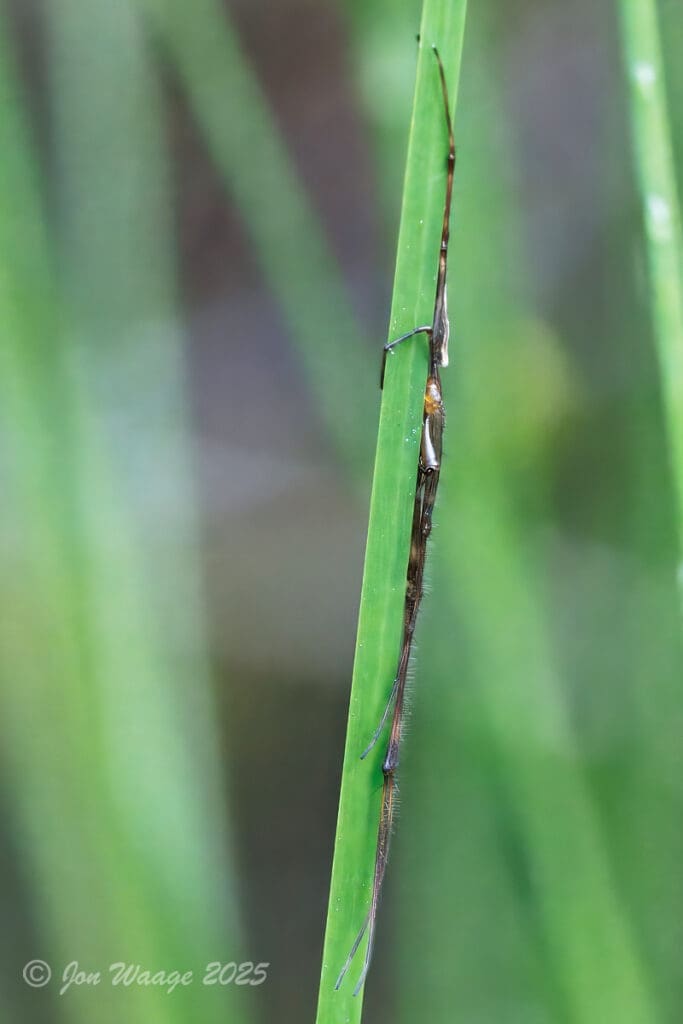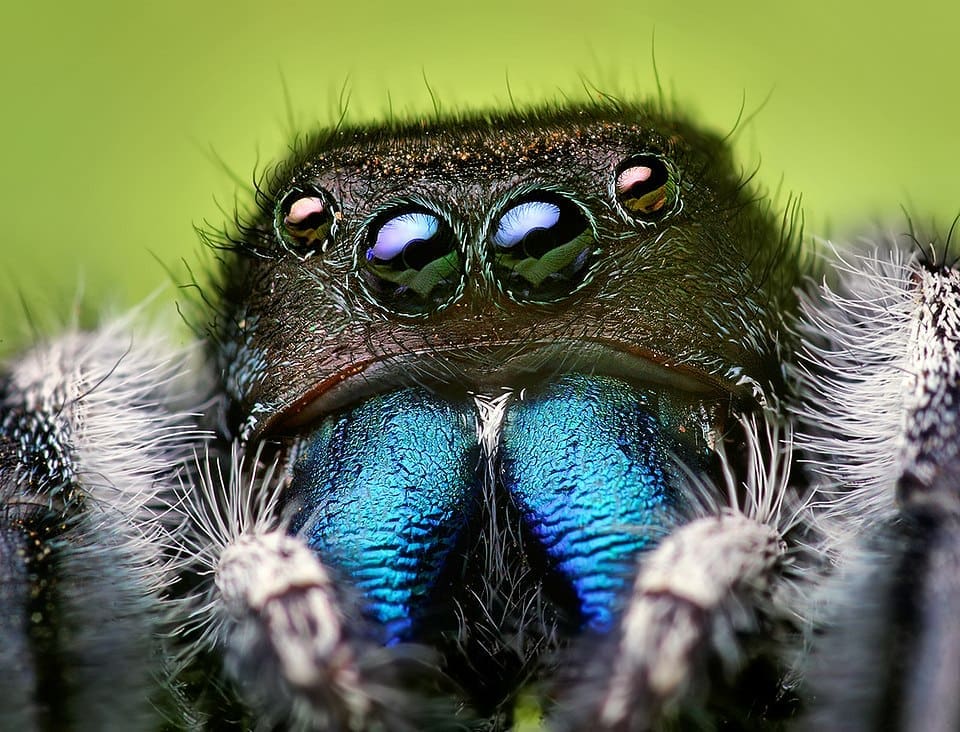Loon Update and Why Spiders Matter
2025, No. 09 — July 29th

|
Loon Update
|
Interactions between our loon pair and the other loons on the lake continue. That means Piper is left on her own a lot, and sometimes she is pretty far out on the lake. Please keep an eye out for her and give her lots of room. If you are passing in a boat, please stay to the lakeside of her so she is not pushed further out on the lake.

Piper is growing and beginning to molt into her juvenile plumage. The light grey patch under her beak in the photo above shows a bit of her new feathers. Below, she is resting behind a docked boat. She uses docks and boats for shelter, so please check before heading out on the lake – especially on the western end of the lake.

|
Spiders Matter
|
If you look closely at the lead photo to this newsletter and the one below, you will notice a lot of spider webs. A misty morning in a meadow will also give you a peek at the real abundance of spiders. Their webs are obvious on such days. As a group, spiders are one of the most important predators in the world, consuming between 2 and 4 times as much animal flesh as the entire human population does! Many people don’t like spiders or think of them as pests. However, because of them, we actually have far fewer insect pests in our yards and even our houses.
The spider webs shown here are in Turtle Cove, which seems an odd place to find insect hunters given all the water. In fact there are a lot of insects for them to eat near the water surface and on emergent vegetation, including dragonflies and damselflies.

Damselflies (and some dragonflies) lay their eggs (oviposit) by inserting them into aquatic plant tissues. Many species oviposit in tandem with the male still attached to the female, as below for this pair of Spreadwings. As a result, they spend time in a very dangerous place – the air-water interface. They are vulnerable to birds and other dragonflies as well as aquatic predators.

The Bullfrog eating a damselfly below is an example. Dragonflies themselves are also important predators in their aquatic juvenile stage. Larvae of large species will eat small fish and tadpoles. “Karma of Nature”?

Let’s pause a minute here and dispel a common myth. Despite the AI generated posts you see on social media, adult dragonflies DO NOT eat hundreds of mosquitoes a day! Having studied them for over 50 years, Jon knows they eat a lot of insects, mostly caught near ponds and streams, and mostly at times of day when mosquitoes are not that active. A recent check of the scientific literature shows that dragonfly and damselfly diets still indicate that less than a few percent of the diets of adults include mosquitoes. Where dragonflies and damselflies do eat mosquitoes is during their larval stage underwater, where they may encounter mosquito larvae.
But back to spiders, which are not food for dragonflies but are lethal enemies. Spider webs catch a lot of insects flying over the water and around shorelines. Among them are damselflies like the one below.

Not all spiders catch insects using webs. Several long-legged species catch their prey by hiding and pouncing on them. Below is an example of local such spider in Turtle Cove.

A Common Stretch Spider (Tetragnatha sp.) hiding

Stretch Spider showing its long legs and body
Long-legged spiders that do not build webs are fairly common near water. They catch insects, like the female damselfly below, as well as other aquatic invertebrates.

|
Spiders are Helpers
|
Many spiders do not use webs to catch prey, and they often have striking morphology and very good eyesight. If you are a hungry spider looking for insects, flowers are a great place to hunt. Below, a Crab Spider (Thomisidae), with its long legs, is eyeing a visiting honeybee.

Most Crab Spiders, like the Goldenrod Crab Spider (Misumenea vatia), eating a small bee below and a butterfly (Skipper) below that, are well camouflaged. This species can, over a few days, even change color to match the flowers it is hunting on.


Jen and I are particularly fond of jumping spiders and welcome them in our house and porch, where they do a good job of catching insects on windows and screens. All spiders have eight eyes, but jumping spiders have four of their eight eyes in a row at the front of their “head”. Two of them are enlarged and give them great vision for several feet and motion detection for a yard or more.

Marbled Purple Jumping Spider (Phidippus purpuratus)
Jumping Spiders live up to their name and can leap many times their body length while trailing a safety line of silk. They also display brilliant colors on their faces during courtship. The very common one below is actually the New Hampshire State Spider. The photo is from Wikipedia on a page that will give you more information about these wonderful spiders. For additional information, here is a recent article the Northern Woodlands Magazine.

Bold Jumping Spider (Phidippus audax)
Jumping Spiders are not only fun to watch, they are very helpful at finding and eating house and garden pests. The one below has caught a winged female aphid. That aphid and the hundreds of aphids she would have given birth to have been removed.

What is so fascinating about nature is all the interdependent connections between species. We all love our Ruby-throated Hummingbird visitors, and many of us provide them with lots of sugar water. However, they feed themselves and their young “meat”, including spiders, fruit flies, gnats, other small insects.

|
Caterpillars also Matter
|
Lots of birds can be attracted to your yard with fruit and nectar, but if you want them to nest or spend more time there, they need to be getting “meat” for themselves and their young.
A great way to attract songbirds is to have native trees that are prone to having caterpillars on them (cherry, birch, aspen …). Below are two examples of great caterpillar removers. Gray Catbirds (below) eat caterpillars as well as ants, beetles, grasshoppers, and midges.
Robins don’t just feed their young worms. Here comes a mouthful of caterpillars.

We know many of you are not fond of spiders or even caterpillars, but we hope you see how important they are in the world. The interconnectedness and interdependence of spiders, insects, and other animals, including us, is fascinating and so very important. It is one reason ecologists and environmentalists are so concerned about the rapid decrease in insect and spider species worldwide. They are the food base for animals we cherish and are essential biological control agents. But the habitats they need are disappeaing.
Our yards are becoming more and more important in fighting that trend, and those yards of closely mown and heavily fertilized grass are not going to help! Please consider planting at least part of your yard with native plants.
Bye for now … Jen and Jon

Text and Photographs by Jen Esten and Jon Waage
